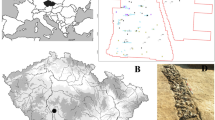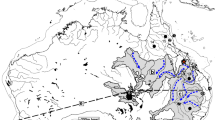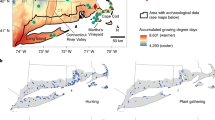Tiny plant fossils indicate how this frozen region once sustained huge herds of mammals.
Abstract
The landmass known as Beringia is an extensive region that existed during the Pleistocene epoch and included the land bridge between present-day Siberia and Alaska, now submerged beneath the Bering Strait. It must have been covered with vegetation even during the coldest part of the most recent ice age (some 24,000 years ago) because it supported large populations of woolly mammoth, horses, bison and other mammals during a time of extensive Northern Hemisphere glaciation, although the nature of this vegetation has not been determined1,2,3. Here we report the discovery of macrofossils of prairie sage (Artemisia frigida), bunch-grasses and forbs that are representative of ice-age steppe vegetation associated with Pleistocene mammals in eastern Beringia. This vegetation was unlike that found in modern Arctic tundra, which can sustain relatively few mammals, but was instead a productive ecosystem of dry grassland that resembled extant subarctic steppe communities4,5.
This is a preview of subscription content, access via your institution
Access options
Subscribe to this journal
Receive 51 print issues and online access
$199.00 per year
only $3.90 per issue
Buy this article
- Purchase on Springer Link
- Instant access to full article PDF
Prices may be subject to local taxes which are calculated during checkout

Similar content being viewed by others
References
Birks, H. H. & Birks, H. J. B. J. Biogeogr. 27, 31–35 (2000).
Guthrie, R. D. Frozen Fauna of the Mammoth Steppe (Univ. Chicago Press, Chicago, 1990).
Cwynar, L. C. & Ritchie, J. A. Science 208, 1375–1377 (1980).
Edwards, M. E. & Armbruster, W. S. Arc. Alp. Res. 21, 296–304 (1989).
Vetter, M. A. Arctic 53, 165–173 (2000).
Anderson, P. M. & Brubaker, L. B. Q. Sci. Rev. 13, 71–92 (1994).
Elias, S. A. et al. Nature 382, 60–63 (1996).
Goetcheus, V. G. & Birks, H. H. Q. Sci. Rev. 20, 135–147 (2001).
Froese, D. et al. Q. Sci. Rev. 21, 2137–2142 (2002).
Harington, C. R. & Eggleston-Stott, M. Curr. Res. Pleist. 13, 105–106 (1996).
Author information
Authors and Affiliations
Corresponding author
Ethics declarations
Competing interests
The authors declare no competing financial interests.
Rights and permissions
About this article
Cite this article
Zazula, G., Froese, D., Schweger, C. et al. Ice-age steppe vegetation in east Beringia. Nature 423, 603 (2003). https://doi.org/10.1038/423603a
Issue Date:
DOI: https://doi.org/10.1038/423603a
This article is cited by
-
Investigating the reliability of metapodials as taxonomic Indicators for Beringian horses
Journal of Mammalian Evolution (2022)
-
Collapse of the mammoth-steppe in central Yukon as revealed by ancient environmental DNA
Nature Communications (2021)
-
Origins and diversity of the Bering Sea Island fauna: shifting linkages across the northern continents
Biodiversity and Conservation (2021)
-
Phylogeography of higher Diptera in glacial and postglacial grasslands in western North America
BMC Ecology (2019)
-
Impact-related microspherules in Late Pleistocene Alaskan and Yukon “muck” deposits signify recurrent episodes of catastrophic emplacement
Scientific Reports (2017)
Comments
By submitting a comment you agree to abide by our Terms and Community Guidelines. If you find something abusive or that does not comply with our terms or guidelines please flag it as inappropriate.



